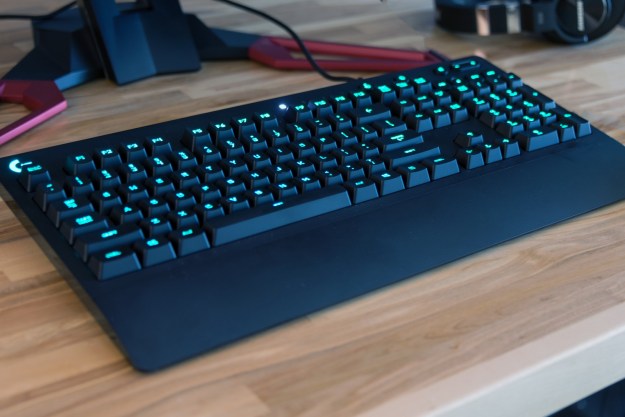
“Logitech’s entry-level gaming feature sacrifices too much in the name of simplicity.”
- Tall key travel
- Spill-resistant design
- Membrane design limits functionality
- Flimsy construction
- Little money saved over mechanical keyboards
- Splotchy backlighting
Logitech is nothing short of prolific when it comes to PC peripherals. Now, according to the company, it’s time to bring some high-end gaming features to users who might not be familiar with them, in the form of the Prodigy line.
For now, the line is just one mouse, the G403 (in wired and wireless versions), and one keyboard, the G213. Both are designed to explain to new keyboard warriors, both young and old, why the PC gaming crew is so enthusiastic about its hardware.
The keyboard lacks mechanical key switches, but it does have five zones of RGB backlighting, media keys, and a game mode that prevents accidental Windows key presses during gameplay. It retails for $70, which means it faces stiff competition from entry-level mechanical keyboards, including some within Logitech’s ranks.
Is the G213 prodigy dead simple, or dead in the water?
Simple can be too simple
Logitech didn’t take any risks with the G213’s design, and that’s intentional. The aesthetic is meant to shoot straight down the middle, appealing to those currently working on keyboards that came free with pre-built PCs. It’s not exceptional, but it works.
Quality, on the other hand, didn’t have us enthused. Even a light touch between the F8 and F9 keys causes immediate, noticeable bending, even if the keyboard feet are closed so the keyboard sits flat against your desk. Beyond that, the keyboard seems too light for how large it is, lending a flimsy, cheap feel to the whole setup. In other products, extra weight might be a disadvantage, but a metal chassis and hefty plastic can keep a keyboard from moving when typing reaches a fevered pitch.
If you’re worried about spilling your Mountain Dew during furious gaming, the G213 has you covered. All of the mounting holes for the switches are elevated inside one big trough. That means small spills – Logitech says up to 60 milliliters – should just slough off the keyboard. After a quick dry, it should work just fine. Mechanical keyboards are usually spill-resistant, but typically require at least 24 hours of soaking and drying before being used again.
Insane in the membrane
Gaming keyboards come in two main flavors – mechanical, and membrane. A mechanical keyboard is built from dozens of individual, physical switches, one under each key, while a member keyboard uses a mat of rubber domes to provide key resistance.
The Prodigy is built with a membrane, instead of mechanical switches, and that’s disappointing. There’s several reasons for this, including but not limited to — greater variety of tactile and audible response, no ghosting or rollover issues (although the G213 registers 13 keys at once with no issue), and deep, satisfying presses perfect for the gamer seeking control.
Which is not to say that membrane keyboards are strictly worse. They handle minor spills better than mechanical competitors, or at least with less down-time. They’re have a lower key profile, which can be preferred by typists who aren’t interested in gaming. And their physical characteristics are ever-improving, not just in laptops like the Asus G752, but in dedicated gaming boards like the Razer Deathstalker.
The Prodigy G213 isn’t bad as membrane keyboards go. Its keys deliver a modest clack, and key height is reminiscent of traditional mechanical keyboards. But something’s still off. Coming from our usual Cherry MX Blue switches, which have a loud audible click to each press, the Logtiech’s membrane keys feel mushy until they bottom out. They’re a strong offering for a membrane keyboard, but still no on par with a true mechanical switch.
Pretty colors
One major advantage of mechanical keyboards is the option to add per-key RGBLED backlighting. Special switches with individually-controlled LEDs underneath have become increasingly popular, although whether they’re a gimmick or a useful feature depends on your point of view. We’ve only seen one example of individual key backlighting in a membrane keyboard so far, and that’s in Razer’s Blade laptop series.
Backlit keys look uneven, especially when they aren’t viewed from directly above.
The Logitech doesn’t buck the trend. It offers backlighting control only in five zones, spread out in columns horizontally across the keyboard. Unlike some keyboards with a similar feature, the lines between the zones are clear, with little to no blending between them. We think the effect is a bit chintzy.
Oddly, the backlight has a blue tinge to it. It’s particularly noticeable with the keycaps removed, where the membrane inside reaches a sky blue tint. Darker colors like red or purple drown it out, but yellow takes on a green hue as a result.
There’s another issue, and it’s not one we’re used to seeing. Each membrane switch is lit from the bottom, and the underside of each keycap has a plastic structure underneath. This supporting material obstructs the light. As a result, a lot of the keycaps look splotchy, especially when they aren’t viewed from straight above.
The software, at least, is solid. There isn’t a lot in the way of special features, like the smartphone integration found on the Logitech G910, and backlighting effects are limited by the large zones, but it works without a hitch — which we can’t say for all of its competitors (*cough* Razer Synapse *cough*).
Its unimpressive lighting wouldn’t be as much of an issue if its competitors didn’t have some of the best backlights in the business. Razer’s BlackWidow, even in its most basic version, has bright, full backlighting that looks far more even than the G213. Logitech’s own mechanical Romer-G keyboard are also far more attractive when lit.
Conclusion
The Logitech G213 Prodigy raises an important question. How do you introduce someone to PC gaming? At Digital Trends, we think that means putting your best foot forward – with a mechanical keyboard.
Whether that’s Logitech’s G610 with choice of Cherry MX Red or Brown for $90, Corsair’s STRAFE with Cherry MX switches for $80, or Razer’s $80 BlackWidow Ultimate, depends on your preferences. But they’re all solid offerings, and all just a few bucks more than the Logitech Prodigy G213.
Those keyboards have a lot in common with the Prodigy, particularly when it comes to feature set and design. But they all have mechanical switches. Nothing compares the feel of a mechanical key switch. It’s one of the little joys of PC gaming, and its absence is all too notable here.
If the G213 were less expensive, then we might understand. At $70, though, the G213 isn’t a budget keyboard. This is solidly mid-range territory, and there are better options – even for newbies.
Editors' Recommendations
- Logitech’s new MX keyboard brings mechanical switches to the masses
- New Logitech wireless headset, colorful gaming peripherals seek mass appeal
- Logitech’s wireless G502 Lightspeed is faster than wired gaming mice







